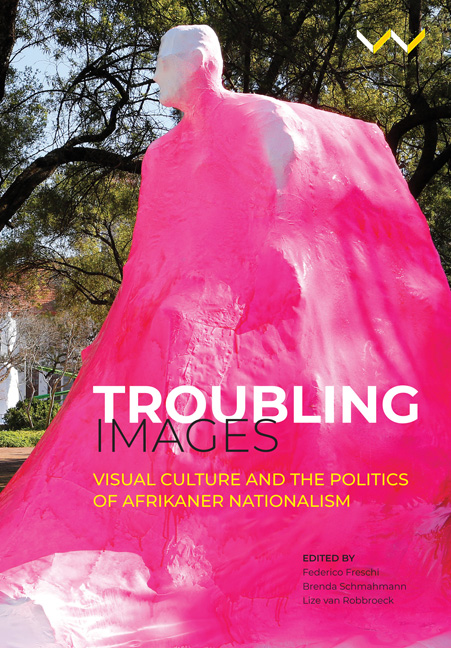Book contents
- Frontmatter
- Contents
- Acknowledgements
- List of Illustrations
- Troubling Images: An Introduction
- 1 The Trajectory and Dynamics of Afrikaner Nationalism in the Twentieth Century: An Overview
- One Assent and Dissent Through Fine Art and Architecture
- Two Sculptures on University Campuses
- Three Photography, Identity and Nationhood
- Four Deploying Mass Media and Popular Visual Culture
- Contributor Biographies
- Index
6 - Knocking Jannie off his Pedestal: Two Creative Interventions to the Sculpture of JH Marais at Stellenbosch University
Published online by Cambridge University Press: 21 March 2020
- Frontmatter
- Contents
- Acknowledgements
- List of Illustrations
- Troubling Images: An Introduction
- 1 The Trajectory and Dynamics of Afrikaner Nationalism in the Twentieth Century: An Overview
- One Assent and Dissent Through Fine Art and Architecture
- Two Sculptures on University Campuses
- Three Photography, Identity and Nationhood
- Four Deploying Mass Media and Popular Visual Culture
- Contributor Biographies
- Index
Summary
On 10 October 1950, a sculpture was unveiled at Stellenbosch University on what was then Jan Marais Square but is currently known as Rooiplein [Red Square] (Fig. 6.1). Carved from white granite and one-and-a-half times life size, the figure is elevated on a plinth that is nearly as high as the first storeys of buildings in its surrounds. Yet, its grandeur of scale and expensive materials are belied by the surprising ordinariness of the physiognomy of the bearded individual it depicts. Dressed in everyday clothing and with his left arm bent in a gesture associated with sincerity and honesty, he stands with his weight distributed equally between his firmly grounded feet. The words J.H. MARAIS ONS WELDOENER [ J.H. MARAIS OUR BENEFACTOR] appear on the front of the pedestal, while on the back are the names of those who donated money to the work's commissioning.
Unassuming as his stance and dress may seem from this rendition, Johannes Henoch Marais (b. 1850), better known as Jannie Marais, was in fact one of the most influential and wealthy individuals in Stellenbosch in the early twentieth century. Its parliamentary representative from 1899 until his death in 1915, he had amassed a fortune on the Kimberley diamond mines and held the largest shareholding in the Stellenbosch District Bank. A primary player in the establishment of the publishing house Nasionale Pers, he was also behind the founding of Die Burger in 1915. Its first editor, DF Malan, would become leader of the Gesuiwerde Nasionale Party [Purified National Party], following his rejection of the Fusion government that JBM Hertzog and Jan Smuts had constituted in 1934, and eventually serve as the first prime minister of the apartheid government elected in 1948. Crucially, in the context of this chapter, Marais's initial bequest of £100 000 had enabled the transformation of Victoria College into the University of Stellenbosch in 1918.
Marais's largesse towards Victoria College was bound up with imperatives to establish a fully fledged and independent university where Afrikaans (Dutch) was foregrounded. Those appointed to manage the Jan Marais Fund were, as Pieter Kapp (2015, 167) notes in his study of Marais and his brothers, ‘all impassioned supporters of Dutch-Afrikaans’.
- Type
- Chapter
- Information
- Troubling ImagesVisual Culture and the Politics of Afrikaner Nationalism, pp. 140 - 166Publisher: Wits University PressPrint publication year: 2020

